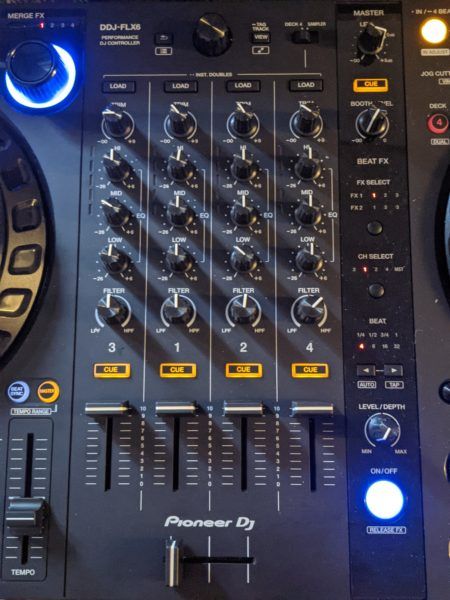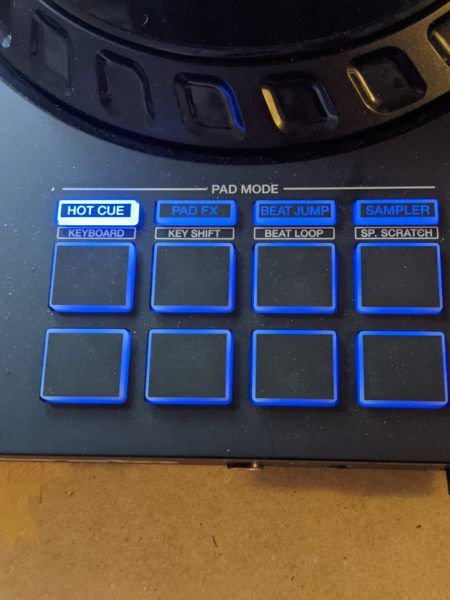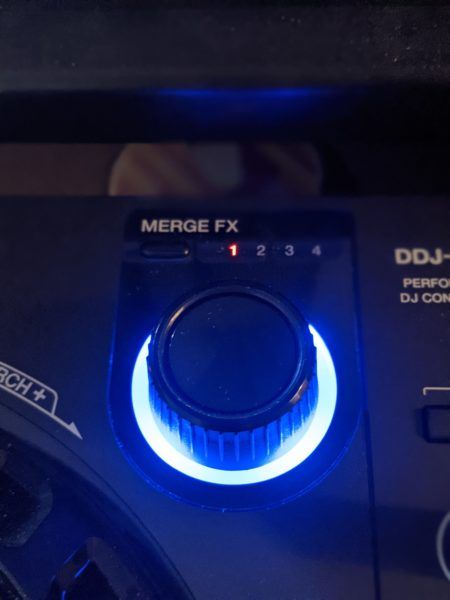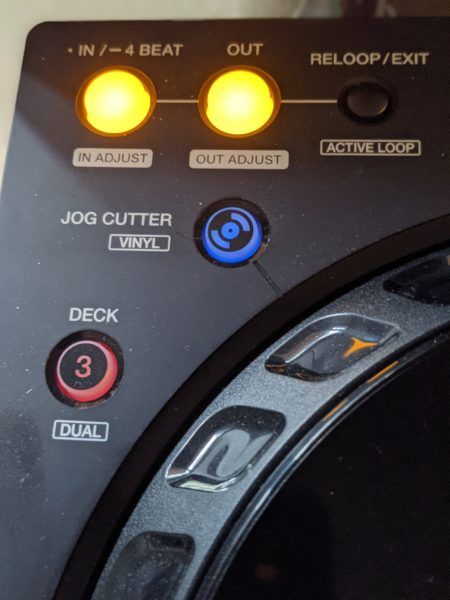Pioneer DJ surprised us all with the release of the new DDJ-FLX6, a $599 Serato/Rekordbox dual compatible DJ controller. The FLX6 feels like a cross between the DDJ-1000 and DDJ-400, offering four channels and full-sized jog wheels by forsaking build quality and connectivity options.
Filling the midrange gap
I’ve always felt that the controller market has been in a bit of a dilemma for home DJs. It doesn’t make sense that home DJs have to spend over $1,000 to get a significant upgrade feature-wise, from $2-300 entry-level units like the DDJ-400. Existing mid-range units such as the DDJ-SR2 and DDJ-800 tend to focus on build quality over performance features, sporting similar layouts to their entry level counterparts while providing improved build quality and advanced connectivity options.
The DDJ-FLX6 looks to be Pioneer DJ’s solution to this market, providing a midrange controller that focuses on performance features. Instead of a standalone mixer section and a metal-reinforced body (like the SR2), the FLX6 sports four channels and full-sized jog wheels – two very enticing features that are generally only found on higher-end Pioneer DJ gear.
Dual software support
The dual Rekordbox/Serato compatibility was a huge shock as well. Controllers have followed the annoying trend of exclusive single-software support for over a decade, and it’s good to see software brands working together again.
That said, the FLX-6 is a Rekordbox unit first and foremost, as its Serato DJ integration isn’t nearly as tight – there’s no MIDI mapping and less customization over features like Merge FX. I did, however, find the unit to be more responsive with Serato DJ, but that may just be due to the fact that Serato DJ has traditionally optimized as a lighter program designed for turntablists.
I/O connectivity
The FLX-6 shows its colors as a home-oriented controller with its I/O selection: a single pair of RCA master outs, a second pair of RCA booth outs, and a single ¼ inch microphone jack with attenuator control. The mic input does not have soundcard connectivity, thus it does not output sound to software recording or streaming programs directly.
That said – if you’re looking to livestream with the FLX-6, you could connect it to an external interface like an iRig Stream or a Focusrite Scarlett 2i2 and route that out to your device of choice. Though it’s not direct, it’s doable.

On the front panel, I was happy to see both ¼ and 3.55 headphone jacks, meaning no flimsy adapters are required to connect professional headphones to the device.
The lack of balanced XLR or ¼ outputs is a turn-off for many pro DJs, as PA systems tend to rely on the greater stability of balanced outputs. This issue could be mitigated with an external soundcard or portable live mixer.
Jog wheels
The main highlight of the FLX-6 is undoubtedly its 7-inch capacitive jog wheels. Despite being capacitive, they act very similar to Pioneer DJ’s infamous CDJ jogs: weighted, noisy, and tactile. The center on-jog displays are a nice touch as well, displaying needle position as well as other info like slip mode.
The mixer, effects, & fader

The four-channel mixer section of the FLX-6 allows for easy four-deck DJing, which opens up many possibilities that other competing midrange devices don’t have. The knobs are plastic and mounted on thick plastic pots, and have a sturdy feel. However, the crossfader is oddly stiff and manifests some significant resolution issues. I had trouble with crab and transformer scratches on the fader, which is a considerable factor for scratch DJs.
The FLX-6 sports an FX strip on the right that is reminiscent of the DJM line. It has one button to toggle between each of the six different effects in Serato and Rekordbox FX banks, which can be chosen by the user. It also has one button to toggle between channel assignment, with Channel 1-4 and Master options. The effect is controlled by a level/depth knob, pair of beat value buttons, and an on/off button. Red LEDs indicate which effect and channel is selected.
Deck controls
Beyond the basics like play and cue buttons, the DDJ-FLX6 has a decent assortment of deck controls alongside its performance pads. The pads themselves are of the clicky rubber variety – quite similar to those on the SB3 – and are unicolor and not RGB.
Oddly enough, the pad modes can’t be edited in Rekordbox, unlike other Rekordbox controllers. The tempo faders are the same as those found on the DDJ-400, with a decent length but modest resolution. Sync and master buttons can be found placed above the fader.

I was disappointed to find no slip mode or reverse buttons, despite there being cue controls and several other new features that have yet to be seen on Pioneer controllers, though – namely Jog Cutter and Merge FX (we’ll talk about those in a moment).
New performance features
Merge FX

The FLX6 has a variety of new performance features, most notably a pair of giant Merge FX encoders. Merge FX seem to work as a “get out of jail free” function of sorts. It creates instant effect buildups when activated and turned and cuts out the previous track when “dropped,” allowing for another track to be subsequently played. While this feature seems useful for EDM DJs as well as a way to recover lost time from a mistake, they can sound quite garish and almost too intense for more minimalist genres like house.
Jog Cutter

Another new feature is the new “jog cutter” mode, which allows the jog wheel to be haphazardly moved to create complex stutter-scratch patterns. Touching different sections of the jog wheel triggers different patterns. While I can imagine situations where the Jog Cutter could be useful, I find the patterns to be too harsh and unpredictable for my tastes and would prefer to do similar fills manually.
Dual-Deck Mode
The FLX6 also has Dual-Deck Mode, a control that assigns one deck’s controls to both layers simultaneously (e.g the left deck would control tracks A and C at the same time.) This allows for many exciting new opportunities, such as loading an acappella and instrumental into separate decks but controlling them as one simultaneous track.
Sample Scratch Mode
Perhaps the FLX-6’s most exciting new feature is the “sample scratch” mode, which was first seen on the recent DJM-S11. Sample scratch allows samples to be loaded to the jog wheel and scratched without taking up a deck. This is a direly needed solution to a long-standing annoyance for scratch DJs, who previously had to load tracks filled with consecutive scratch samples and navigate them with hot cues.
Conclusion: great for feature upgrades without hurting your wallet.
Pioneer DJ’s DDJ-FLX6 is a bedroom-oriented controller focused on performance features. With full-sized jogs, four channels, and a plethora of new (albeit slightly confusing) performance features, the FLX6 is very enticing for hobbyist DJs who want features without breaking the bank. The unit’s Serato and Rekordbox compatibility is also quite exciting.
I predict that the FLX6 will sell quite well with home DJs, who finally have an affordable four-channel controller with large jogs. While the unit does have some gimmicks that are confusing to pro DJs, I think hobbyists DJing for fun will enjoy the spontaneous, feature-laden controller.
As for the professional market, I believe a Mk2 version is needed with balanced outputs before the FLX can be viable for them. Nonetheless, the FLX6 has found a seemingly untouched niche in the DJ market, and will likely sell very well to lower-budget hobbyist DJs.
The DDJ-FLX6 is priced at $599, and available in the DJ TechTools shop here.





